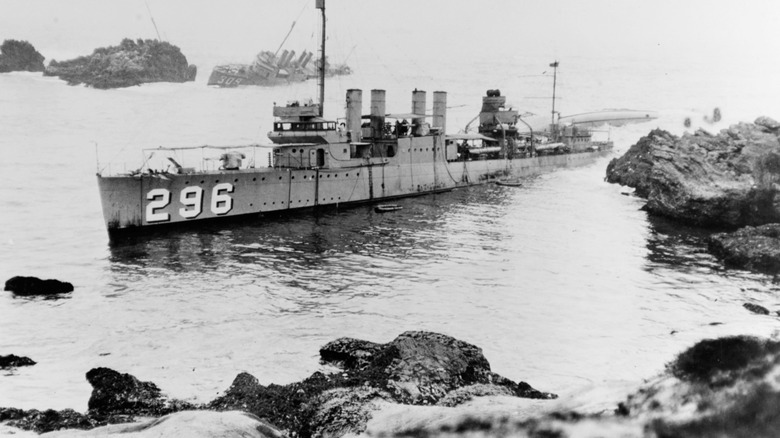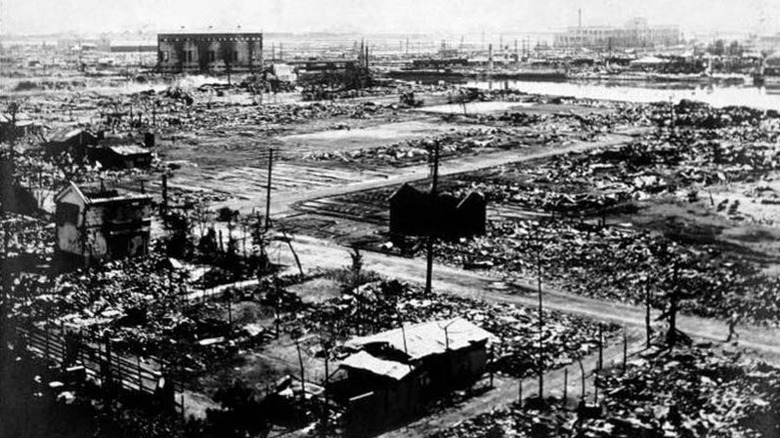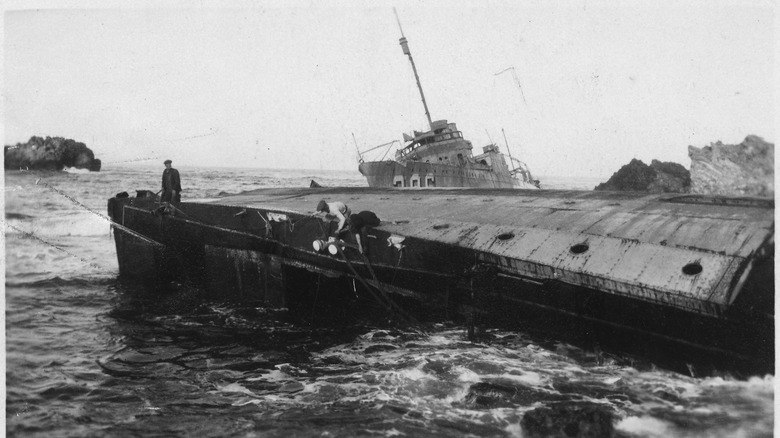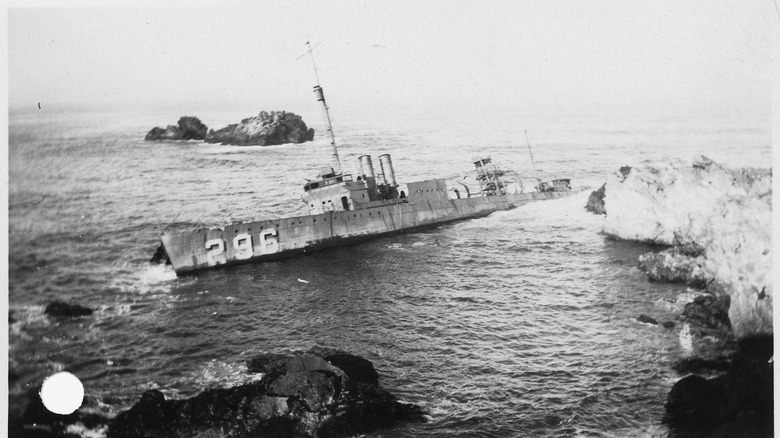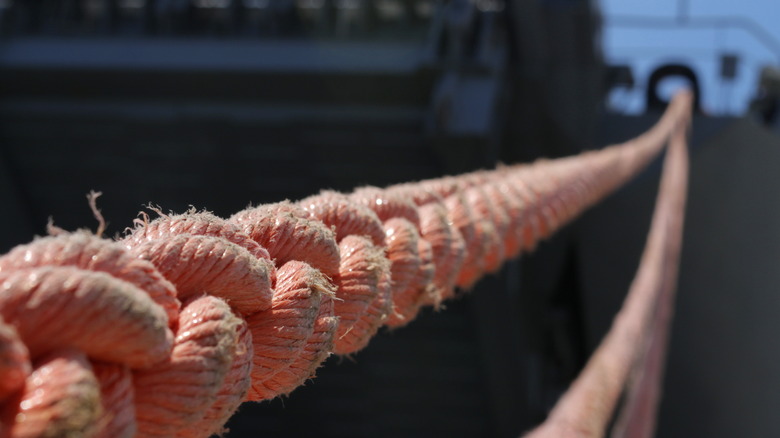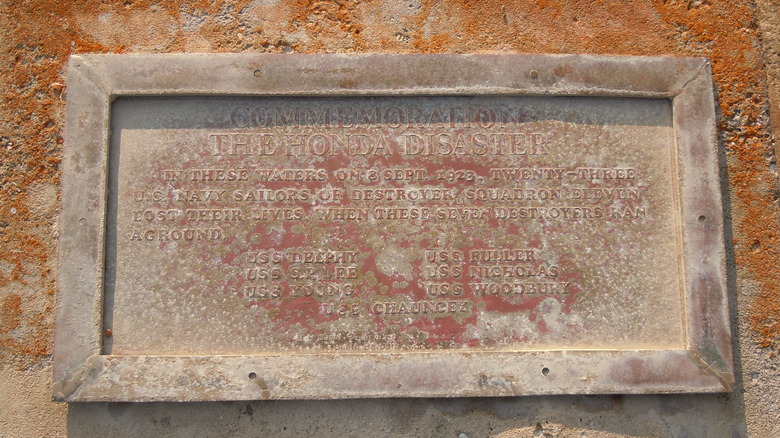Honda Point Disaster: The Largest Loss Of US Navy Ships During Peacetime
Some disasters can be caused by people making mistakes, bad weather, or a combination of the two. Unfortunately, the loss of life and U.S. Navy ships at California's Honda Point was an example of that last. A natural disaster had unforeseen effects combined with human error, which resulted in the largest loss of U.S. Navy ships during peacetime. On September 1, 1923, the Great Kanto earthquake hit Japan. With a magnitude of 7.9, it ripped through the island of Honshu, explains the Naval History Magazine. Though the quake happened 5,000 miles away, the resulting ocean swells and strong currents affected the Pacific Ocean along a route 14 U.S. Navy destroyers took to get to San Diego Bay a week later.
The Clemson-class destroyers full of U.S. Navy sailors set out from San Francisco Bay to San Diego Bay to work on different training maneuvers. As a part of their path, the destroyers had to cross the Santa Barbara Channel. Just north of the channel lies Honda Point, as well as various sharp rocks known as the Devil's Jaw, according to Naval-History.net. Unfortunately, the U.S. Navy ships never actually got through the Santa Barbara Channel. Instead, several hit a landmass of Honda Point and crashed.
How an earthquake affected the disaster
On September 1, 1923, a powerful 7.9 magnitude earthquake occurred on the Japanese island of Honshu, disrupting several cities and killing over 100,000 people (via Naval History Magazine). The earthquake lasted approximately 14 seconds in Yokohama but was enough to destroy nearly every building, writes Smithsonian Magazine. The resulting swells traveled the ocean to reach as far as the California coastline.
The Great Kanto Earthquake destroyed the cities of Tokyo and Yokohama, according to the Naval History Magazine. The damage to Japan's buildings and roads cost over $15 billion in today's currency. The force of the earthquake was such that it created out-of-season swells and ocean currents all over the world, including near the Santa Barbara Channel a week later as the 14 destroyers neared it. Despite unfavorable weather conditions, which included poor visibility as the day went on, the squadron was still sent out to practice different exercises, with Captain Edward H. Watson operating as though the ships were in wartime conditions. He ordered the other ships to make a column, or line up together, near USS Delphy, his ship, as the day wore on to help lower the possibility of problems (via Naval History and Heritage Command). Unfortunately, the earthquake's strength added to the series of issues that led to the Honda Point disaster, and no one could completely stop it from happening.
Navigating by dead reckoning
A total of 14 U.S. Navy ships traveled from San Francisco Bay to San Diego Bay on September 8, 1923. As the day wore on, the fog grew worse, and it became harder to see. The ships were mainly navigating by dead reckoning, or navigating using a previously fixed position, and then estimating speed, direction, and their overall course over time, writes the Naval History Magazine.
Unfortunately, the disaster was the perfect cocktail of problems: poor visibility, unexpected ocean swells, and navigational mistakes. Along their route, the ships, also known as Destroyer Squad 11, worked on gunnery and tactical maneuvers, writes Naval History and Heritage Command. USS Delphy had new radio navigational aids on board, but Captain Edward H. Watson didn't trust them, and so radio navigation was only used to augment dead reckoning. This would prove a tragic decision only hours later.
In the evening, the navigator of USS Delphy used his own calculations to confirm they had reached the Santa Barbara Channel and were ready to turn. His radio navigation indicated they were actually several miles off to the northeast, but the navigator chose to trust his own work instead. Captain Watson had his squadron traveling at a speed of 20 knots to simulate wartime conditions and didn't want to slow down to check whether their plan was safe (via the Naval History Magazine). Most people think it's better to be safe than sorry, but that wasn't the case that day.
23 dead and seven ships lost
Over the course of the afternoon, seven ships ran aground on the rocks near Honda Point, known as the Devil's Jaw and often avoided by local sailors. The heavy fog meant exceedingly poor visibility as the sailors neared Honda Point, meaning they couldn't see what they were crashing into. Ultimately, the hull of USS Young was the first to be destroyed on the rocks. Water that rushed in as the ship capsized began to trap the engine and fire crew, writes the Naval History Magazine.
USS Delphy hit the rocks and crashed ashore at the speed of 20 knots, or 20 nautical miles per hour. USS Chauncey similarly crashed nearby, writes Naval History and Heritage Command. Several of USS Chauncey's men wanted to help those on USS Delphy before USS Chauncey itself crashed. The other seven ships in the squadron managed to avoid the disaster. Two ships were able to get back up and out of danger before hitting any rocks, while the other five abandoned formation completely and didn't run aground at all.
In total, 23 sailors, spaced out through different positions on USS Delphy and USS Young, died during the disaster. Many years after the disaster, several of the destroyers were sold as either wrecks or hulks. Certain parts were salvaged, while others were left either to the depths of the Pacific or to be junked, according to Naval-History.net.
Lifelines and rescues
Several local fishermen came by to help after hearing shouting, shrieking alarms, and seeing the twisted hunks of metal. Sailors from the five undamaged destroyers also jumped into rescue mode and began seeking out their shipmates onboard the other ships. The sailors were not all safely rescued until the next afternoon, writes Naval History Magazine.
Lifelines were strung up that allowed sailors to wade back into shore, nearby islands, or to other ships, according to Naval History and Heritage Command and Naval-History.net. A lifeline was strung up between USS Chauncey and USS Young by Chief Boatswain's Mate Arthur Peterson, who risked his life in swimming the distance between the two ships. Seven men used a life raft and made 11 trips between the two ships, bringing back 70 men from USS Young. Though 20 lives were lost on that ship, Lieutenant Commander William Lowndes Calhoun was later praised during the investigation into the disaster for his efforts and "coolness, intelligence, and seamanlike ability" that helped in the "greatly reduced loss of life" with his rescue efforts (via Naval History and Heritage Command).
Naval-History.net writes that USS Woodbury ran aground near a small island that was later named 'Woodbury Rock' due to its status as a landing pad for the sailors who climbed over the gap between the island and the ship using hawsers, which were thick cables used for towing boats, or in this case, holding them in place.
The court martial
Following the disaster, a court of inquiry took several weeks to sort through what had happened and who was ultimately at fault. The court eventually recommended 11 officers undergo a court martial, which occurred soon after. This list included Captain Edward H. Watson, Lieutenant Commander Hunter, and Lieutenant (junior grade) Lawrence Blodgett from USS Delphy, two commanders whose sections lost men, and all of the captains from the crashed ships (via National Stereoscopic Association and Naval History Magazine). Several officers, including Watson, were found guilty, according to the Naval History Magazine. Watson and Hunter lost any chance of further promotion, though the verdict of another officer who was also found guilty, Lieutenant Commander H. O. Roesch of USS Nicholas, was set aside. Hunter accepted full responsibility for the navigational errors. Many small discrepancies in the ship's logs were not recorded nor discussed at the court marital.
Watson and Hunter both retired six years later. Several other officers did eventually progress into holding command positions. However, nothing fundamentally changed how the U.S. Navy reacted to incidents due to the Honda Point disaster. During the inquiry, 23 men, including officers, were singled out for their efforts in rescuing others. Of the incident, one Navy officer wrote (via Naval History Magazine): "The price of good navigation is constant vigilance."
